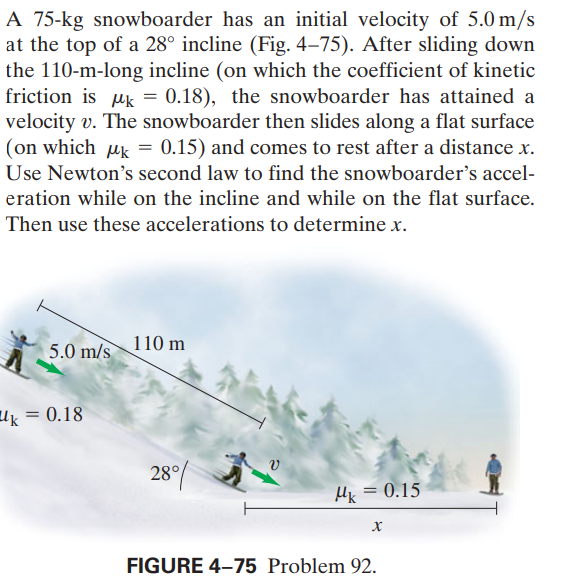A 75-kg snowboarder has an initial velocity of 5.0 m/s at the top of a 28° incline (Fig. 4–75). After sliding down the 110-m-long incline (on which the coefficient of kinetic friction is uk = 0.18), the snowboarder has attained a velocity v. The snowboarder then slides along a flat surface (on which uk = 0.15) and comes to rest after a distance x. Use Newton's second law to find the snowboarder's accel- eration while on the incline and while on the flat surface. Then use these accelerations to determinex. 5.0 m/s 110 m Uk = 0.18 %3D 28°/ Hk = 0.15 FIGURE 4–75 Problem 92.
A 75-kg snowboarder has an initial velocity of 5.0 m/s at the top of a 28° incline (Fig. 4–75). After sliding down the 110-m-long incline (on which the coefficient of kinetic friction is uk = 0.18), the snowboarder has attained a velocity v. The snowboarder then slides along a flat surface (on which uk = 0.15) and comes to rest after a distance x. Use Newton's second law to find the snowboarder's accel- eration while on the incline and while on the flat surface. Then use these accelerations to determinex. 5.0 m/s 110 m Uk = 0.18 %3D 28°/ Hk = 0.15 FIGURE 4–75 Problem 92.
Physics for Scientists and Engineers, Technology Update (No access codes included)
9th Edition
ISBN:9781305116399
Author:Raymond A. Serway, John W. Jewett
Publisher:Raymond A. Serway, John W. Jewett
Chapter5: The Laws Of Motion
Section: Chapter Questions
Problem 5.47P: A block is given an initial velocity of 5.00 m/s up a frictionless incline of angle = 20.0 (Fig....
Related questions
Question

Transcribed Image Text:A 75-kg snowboarder has an initial velocity of 5.0 m/s
at the top of a 28° incline (Fig. 4–75). After sliding down
the 110-m-long incline (on which the coefficient of kinetic
friction is uk = 0.18), the snowboarder has attained a
velocity v. The snowboarder then slides along a flat surface
(on which uk = 0.15) and comes to rest after a distance x.
Use Newton's second law to find the snowboarder's accel-
eration while on the incline and while on the flat surface.
Then use these accelerations to determinex.
5.0 m/s
110 m
Uk = 0.18
%3D
28°/
Hk = 0.15
FIGURE 4–75 Problem 92.
Expert Solution
This question has been solved!
Explore an expertly crafted, step-by-step solution for a thorough understanding of key concepts.
This is a popular solution!
Trending now
This is a popular solution!
Step by step
Solved in 3 steps with 3 images

Recommended textbooks for you

Physics for Scientists and Engineers, Technology …
Physics
ISBN:
9781305116399
Author:
Raymond A. Serway, John W. Jewett
Publisher:
Cengage Learning

Physics for Scientists and Engineers, Technology …
Physics
ISBN:
9781305116399
Author:
Raymond A. Serway, John W. Jewett
Publisher:
Cengage Learning